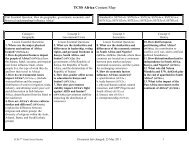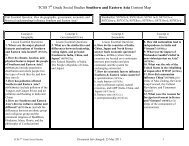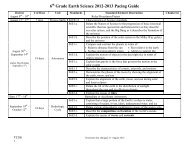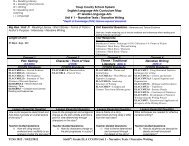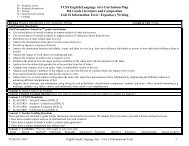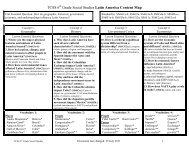TCSS 2012 / 9/27/2012 Seventh (7 ) Grade ELA CCGPS Unit 3 ...
TCSS 2012 / 9/27/2012 Seventh (7 ) Grade ELA CCGPS Unit 3 ...
TCSS 2012 / 9/27/2012 Seventh (7 ) Grade ELA CCGPS Unit 3 ...
You also want an ePaper? Increase the reach of your titles
YUMPU automatically turns print PDFs into web optimized ePapers that Google loves.
RL= Reading Literary<br />
RI = Reading Informational<br />
W = Writing<br />
SL= Speaking and<br />
Listening<br />
L = Language<br />
Big Idea / <strong>Unit</strong> #3<br />
Length of <strong>Unit</strong><br />
Reading Informational / Nonfiction<br />
Informational Texts<br />
26 days<br />
Troup County School System<br />
English/Language Arts Curriculum Map<br />
<strong>Seventh</strong> (7 th) <strong>Grade</strong><br />
<strong>Unit</strong> # 3 – Informational Texts/ Expository Writing<br />
*Depth of Knowledge (DOK) follows required standards<br />
<strong>Unit</strong> Essential Questions:<br />
How can reading help you make decisions or solve problems?<br />
How do our attitudes influence the changes and challenges we<br />
face in life?<br />
Text Resources:<br />
Elements of Literature<br />
<strong>Unit</strong> 3 – pp. 482-641<br />
Concept 1 Concept 2 Concept 3 Concept 4<br />
Textual Evidence<br />
Elements of Nonfiction<br />
Central Ideas in<br />
Nonfiction<br />
Author’s Style<br />
Word Choice /<br />
Structure<br />
Author’s Perspective<br />
Point of View / Purpose<br />
Use of Rhetoric / Claims / Ideas<br />
<strong>CCGPS</strong> Standards <strong>CCGPS</strong> Standards <strong>CCGPS</strong> Standards <strong>CCGPS</strong> Standards<br />
<strong>ELA</strong>CC7RI1.a– Textual Evidence<br />
<strong>ELA</strong>CC7RI1.b - Inferences<br />
<strong>ELA</strong>CC7RI10- Comprehension<br />
DOK 2 / 3<br />
<strong>ELA</strong>CC7RI2.a-Determine central idea (DOK 2)<br />
<strong>ELA</strong>CC7RI2.b- Develop central idea (DOK 2)<br />
<strong>ELA</strong>CC7RI2.c- Objective Summary (DOK 2)<br />
<strong>ELA</strong>CC7RI3 – Analyze interactions (DOK 2)<br />
<strong>ELA</strong>CC7RI4.a-Determine<br />
<strong>ELA</strong>CC7RI4.b- Analyze<br />
<strong>ELA</strong>CC7RI5- Structure<br />
(DOK 2/3)<br />
Lesson Essential Questions Lesson Essential Questions Lesson Essential<br />
Questions<br />
1) How do I find and cite textual<br />
evidence to support my analysis<br />
of the text?<br />
2) How do I find textual evidence<br />
to support my analysis of<br />
inferences drawn from the text?<br />
3) How does a story’s content<br />
directly relate to inferences?<br />
1. How can I determine the central<br />
idea/ideas of Informational text?<br />
2. Why is objective summary important<br />
when summarizing an informational text?<br />
3. How do ideas, individuals, or events<br />
influence informational text?<br />
1. How does word choice<br />
affect meaning and tone<br />
in informational text?<br />
2. How do I determine<br />
textual meaning through<br />
the use of context<br />
clues?<br />
3. How does structure and<br />
organization contribute<br />
to understanding in<br />
reading informational<br />
<strong>ELA</strong>CC7RI6.a- Purpose – (DOK 2)<br />
<strong>ELA</strong>CC7RI6.b- Opinion- (DOK 2)<br />
<strong>ELA</strong>CC7RI7- Compare and contrast (DOK 2 / 3<br />
<strong>ELA</strong>CC7RI8 - Claims (DOK 2)<br />
<strong>ELA</strong>CC7RI9 – 2 or more ideas<br />
Lesson Essential Questions<br />
1. How does an author’s point of view or purpose<br />
distinguish his or her opinion from that of other<br />
writers?<br />
2. How can a text be different from one type of<br />
presentation to another?<br />
3. How do authors often differ on their<br />
presentation of the same informational topic?<br />
<strong>TCSS</strong> <strong>2012</strong> / 9/<strong>27</strong>/<strong>2012</strong> <strong>Seventh</strong> (7 th ) <strong>Grade</strong> <strong>ELA</strong> <strong>CCGPS</strong> <strong>Unit</strong> 3 – Informational Texts/ Expository Writing 1
Vocabulary Vocabulary Vocabulary Vocabulary<br />
textual evidence<br />
analysis<br />
inferences<br />
supporting evidence(details)<br />
explicit text<br />
fact/opinion<br />
skimming and scanning<br />
prediction<br />
Resources<br />
Elements of Literature –<br />
Informational Text Focus –<br />
Reading for Life – 580;<br />
Reading Skills / Informational Texts<br />
(Check the list on A<strong>27</strong>);<br />
“Preview the Text” – 599, 613;<br />
Summarizing an Informational Text<br />
102; Public Documents – 591;<br />
Workplace Documents – 599;<br />
Consumer Documents<br />
– 605; Technical Directions –<br />
613;”What Helps You<br />
Read Documents?” – 584; “What<br />
skills and strategies help you read<br />
nonfiction? – 490;<br />
Evaluating Evidence 868<br />
Holt Teacher Resources<br />
Collection 5 – Informational Texts;<br />
Collection 6 –Reading for Life<br />
Elements of Language (Holt)<br />
“Making Inferences - 240, 259, 720;<br />
“What is an Inference and How Do I<br />
Make One?” Drawing Conclusions –<br />
568; 955;<br />
Questioning / Predicting” p. 604 –<br />
“Making Predictions” – 161, 389,<br />
399, 941 (Keep On Reading) Cross<br />
Curricular - Inferences <strong>Unit</strong> 5 – 90-91<br />
Informational Text:<br />
Books<br />
Magazines<br />
Newspapers<br />
Workplace documents<br />
Advertisements<br />
Brochures<br />
Resources<br />
Central Idea:<br />
Central idea<br />
Main idea<br />
Development<br />
Objective summary<br />
Interaction<br />
Detail<br />
events<br />
Elements of Literature – “Finding the Main Idea”<br />
497, 509; Questioning the Text 659; Summarizing<br />
Information 644, 650-651<br />
Elements of Language<br />
“How do you Predict, Visualize, Summarize? –<br />
134;<br />
“Skimming and Scanning” 591; Implied Main Idea<br />
504; Outlining and Summarizing 86<br />
*Holt Teacher Resources<br />
Collection 5 – Informational<br />
Collection 6 – Reading for Life<br />
Elements of Literature<br />
“Comparing and Contrasting Across Texts”<br />
75;Comparison & Contrast 313;Distinguishing Fact<br />
from Opinion – 525; Cause and Effect-619;<br />
Identifying Author’s Evidence – 452; (i.e. “Green-<br />
Haired Girl” 592 / Reading for Life <strong>Unit</strong>)<br />
connotation<br />
denotation<br />
figurative language<br />
contrast<br />
restatement<br />
tone<br />
meanings<br />
structure / section<br />
Resources<br />
Elements of Literature<br />
“Vocabulary Skills Review” –<br />
pp.122; 240; 334; 478;<br />
574; 636; 754; 892; 1010;<br />
Connotations and Denotations<br />
60; 259, 268, <strong>27</strong>1; 280; Sensory<br />
Language 681 Shades of<br />
Meaning 72 Word,<br />
Sentence, and Paragraph Clues<br />
– 294; Analyzing Figures of<br />
Speech – 718-722<br />
Context Clues 40<br />
Elements of Literature<br />
“Identify Bias and Stereotyping” –<br />
456; “A Writer’s<br />
Message” – 725; Evaluating<br />
Arguments – 446; Word<br />
Power / Connotations 259, 268,<br />
<strong>27</strong>1, 280 ; Revising:<br />
Using Emotional Language 739<br />
Holt Teacher Resources<br />
Collection 5 and Collection 6<br />
Elements of Literature<br />
Structure of a Newspaper Article<br />
207; Structure and Purpose of a<br />
Textbook 211; Structure and<br />
Purpose of an Instructional<br />
Manual 217; Structure and<br />
Purpose of Signs 221; Analyzing<br />
an Author’s Techniques 181<br />
point of view<br />
author’s purpose<br />
to inform<br />
word choice<br />
tone<br />
author’s opinion<br />
audio<br />
film<br />
documentary<br />
multimedia<br />
instructions<br />
data<br />
graphs<br />
charts<br />
electronic media<br />
power point<br />
maps<br />
photos<br />
highlighted vocabulary<br />
author’s experience<br />
author’s background<br />
evidence<br />
credibility<br />
comparison / contrast<br />
memoir<br />
biography<br />
autobiography<br />
Resources<br />
Elements of Literature<br />
“Author’s Purpose and Perspective” – 546, 547,<br />
988, 989; Evaluating arguments – 446; Structure<br />
and Purpose of Informative Texts 102 (Definition)<br />
206, 207, 217, 221; “Identifying and Evaluating<br />
Author’s Evidence” – 86<br />
Elements of Literature<br />
Evaluating Arguments 446; “Identifying and<br />
Evaluating Author’s Evidence” 869; Identify and<br />
Evaluate Author’s Evidence – 452; “Questioning<br />
the Text 659 (More literary than Informative)<br />
Comparing Texts – pp. 619, 624<br />
Elements of Language – Mini-Lesson: “Telling<br />
the Difference Between Fact and Opinion” –<br />
697;Mini-Lesson – “Analyzing Target Markets and<br />
Advertisements” 728 www.gadoe.org<br />
Frameworks Persuasive Texts9<br />
Elements of Literature<br />
Evaluating Arguments – 446; “Identifying and<br />
Evaluating Author’s Evidence” 869; Identify and<br />
Evaluate Author’s Evidence – 452; “Questioning<br />
the Text 659 (More literary than informative<br />
Elements of Literature –Nonfiction / Reading for<br />
Life – pp. 580-624; Informational Text Skills –<br />
591,599, 605, 613; Informational Skills Practice<br />
(End of each <strong>Unit</strong>)<br />
Elements of Language Reading and Writing<br />
Workshops - Chapter 24 Finding and Reporting<br />
<strong>TCSS</strong> <strong>2012</strong> / 9/<strong>27</strong>/<strong>2012</strong> <strong>Seventh</strong> (7 th ) <strong>Grade</strong> <strong>ELA</strong> <strong>CCGPS</strong> <strong>Unit</strong> 3 – Informational Texts/ Expository Writing 2
Elements of Language – Writing<br />
Workshop (Ch 24) A Report of<br />
Information / Content and<br />
Organization 669 (Ch 26) A Print<br />
Advertisement / Content and<br />
Organization 739<br />
Information – pp. 642-685; Chapter 25 –<br />
Convincing Others – pp. 687-717; Chapter 26 –<br />
Advertising – 718-751<br />
Concept 5 Concept 6 Concept 7 Concept 8<br />
Informational Writing<br />
Speaking and Listening<br />
<strong>CCGPS</strong> Standard <strong>CCGPS</strong> Standard <strong>CCGPS</strong> Standard <strong>CCGPS</strong> Standard<br />
<strong>ELA</strong>CC7W<br />
<strong>ELA</strong>CC7W2a<br />
<strong>ELA</strong>CC7W2a1<br />
<strong>ELA</strong>C7CW2a2<br />
<strong>ELA</strong>C7CW2b-f<br />
(DOK 3)<br />
<strong>ELA</strong>CC7W4<br />
<strong>ELA</strong>CC7W5<br />
<strong>ELA</strong>CC7W7<br />
<strong>ELA</strong>CCW8a-d<br />
<strong>ELA</strong>CC7W9<br />
<strong>ELA</strong>CC7W10 (DOK 3)<br />
Lesson Essential Questions Lesson Essential Questions Essential Questions Lesson Essential Questions<br />
1. How do I write<br />
informative texts to<br />
convey my ideas,<br />
concepts, and<br />
information as clearly<br />
as possible?<br />
2. How do I introduce and<br />
organize my topic<br />
effectively?<br />
3. How do I choose the<br />
correct form of<br />
organization and use<br />
graphics for<br />
informational writing?<br />
4. How do organization,<br />
style, and conventions<br />
help create a cohesive<br />
informational essay?<br />
1. How does a writer produce clear,<br />
organized, and proficient writing?<br />
2. How does a writer become strong,<br />
and independent on any topic?<br />
3. How does good creditable<br />
research generate additional<br />
related focused questions?<br />
4. How do I use the internet to<br />
gather relevant information from<br />
both print and digital sources?<br />
5. Why is it important to follow MLA<br />
guidelines?<br />
Vocabulary Vocabulary Vocabulary Vocabulary<br />
Expository writing Clarity<br />
Concepts Formal Style<br />
Ideas Cohesion<br />
Relevancy<br />
Organization<br />
Multi media<br />
Quotations<br />
Transitions<br />
Production of writing<br />
Development<br />
Proficient writer<br />
Writing process<br />
Multiple print sources<br />
Credibility<br />
Plagiarism<br />
MLA standard format<br />
<strong>TCSS</strong> <strong>2012</strong> / 9/<strong>27</strong>/<strong>2012</strong> <strong>Seventh</strong> (7 th Resources Resources Resources<br />
) <strong>Grade</strong> <strong>ELA</strong> <strong>CCGPS</strong> <strong>Unit</strong> 3 – Informational Texts/ Expository Writing 3
Elements of Language<br />
Parts of the Paragraph - Introduction<br />
and Clincher 475-480; Transitional<br />
Words and Phrases – 488; Order of<br />
Details 483; Chapter 20 – Writing<br />
about an Event 502-533; Chapter 21<br />
Explaining a Process 534-565;<br />
Chapter 22 – Looking at Both Sides<br />
– 567-601; Chapter 24 – Finding and<br />
Reporting Information 642-685<br />
Elements of Language<br />
Quick Reference Handbook –<br />
Manuscript Style; Desktop<br />
Publishing; and Graphics – 756-762<br />
Chapter 18 – Writing Effective<br />
Sentences 454-472 (Includes<br />
revising a paragraph by improving<br />
sentence style) Jefferson County<br />
Schools Website – Writing<br />
“The Hook” – Power Point – How to<br />
Introduce a Paper”<br />
Elements of Language<br />
Elements of Language<br />
Quick Reference Handbook –<br />
Manuscript Style; Desktop<br />
Publishing; and Graphics – 756-762<br />
Chapter 18 – Writing Effective<br />
Sentences 454-472 (Includes<br />
revising a paragraph by improving<br />
sentence style) <strong>TCSS</strong> – MLA<br />
Handbook (See 6-12 Teacher<br />
Resources)<br />
Elements of Language Parts of the<br />
Paragraph - Introduction and<br />
Clincher 475-480; Transitional<br />
Words and Phrases – 488; Order of<br />
Details 483; Chapter 20 – Writing<br />
about an Event 502-533; Chapter 21<br />
Explaining a Process 534-565;<br />
Chapter 22 – Looking at Both Sides<br />
567-601; Chapter 24 – Finding and<br />
Reporting Information 642-685<br />
Elements of Language – Chapter 20 “Showing<br />
instead of Telling” 513; Content and Organization;<br />
Style (Using precise adjectives and nouns) 522-<br />
525 Troup County’s <strong>ELA</strong> Handbook for Writing<br />
Includes specific requirements for number of<br />
essays, type of research project etc. for each<br />
grade level of <strong>ELA</strong><br />
Elements of Language Chapter 20 – 26 includes<br />
sections called “Revising” and “Publishing” –<br />
Chapter 20, 522, 525-529; Ch. 21 – 555, 558-561;<br />
Ch. 22 – 588, 591-596; Ch. 23, 625, 628-632; Ch.<br />
24, 669, 672-675; Ch. 25 – 708, 711-713; Ch. 26 -<br />
739, 742-745<br />
Elements of Language<br />
Chapter 24 – Finding and Reporting Information –<br />
643- 675 (Includes Summarizing Information,<br />
Evaluating sources, Framework for a Report of<br />
Information, and Formatting Sources)<br />
Elements of Language – Chapter 24 Finding and<br />
Reporting Information (Includes “Evaluating<br />
Sources” 654); Writing to Explain 674<br />
Elements of Language – Chapter 24 Finding and<br />
Reporting Information (Includes “Evaluating<br />
Sources” 654); Writing to Explain 674<br />
Elements of Literature (Holt) Research Strategies<br />
1044; Listing and Citing Sources / Taking Notes<br />
1047<br />
Elements of Language<br />
Analyzing Electronic Journalism 1050; Document<br />
Design (Includes Manuscript Style, Desktop<br />
Publishing, and Graphics) 756-762; Analyzing<br />
Credibility 261; Identify and Evaluate Author’s<br />
Evidence 542, 869; Analyzing an Author’s<br />
Perspective 547, 989; Formatting Sources 672<br />
Formatting Sources 672<br />
Elements of Language<br />
Chapter 18 – Writing Effective Sentences 454-472<br />
(Includes revising a paragraph by improving<br />
sentence style)<br />
<strong>TCSS</strong> Expository Writing<br />
Prompts Provided for unit and<br />
mock writing / Expository Writing<br />
Rubric and Checklist – Teacher<br />
Resources 6-12<br />
Elements of Literature – Skills<br />
Reviews for Writing 123, 241,<br />
335, 479, 575, 755, 893, 1011<br />
6 + 1 Writing Traits – “Style”<br />
Jefferson County Website<br />
http://jc-schools.net/PPTs-la.htm<br />
<strong>TCSS</strong> <strong>2012</strong> / 9/<strong>27</strong>/<strong>2012</strong> <strong>Seventh</strong> (7 th ) <strong>Grade</strong> <strong>ELA</strong> <strong>CCGPS</strong> <strong>Unit</strong> 3 – Informational Texts/ Expository Writing 4



